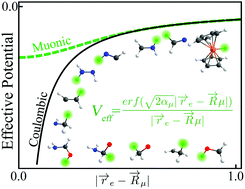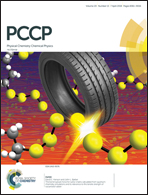Effective electronic-only Kohn–Sham equations for the muonic molecules†
Abstract
A set of effective electronic-only Kohn–Sham (EKS) equations are derived for the muonic molecules (containing a positively charged muon), which are completely equivalent to the coupled electronic–muonic Kohn–Sham equations derived previously within the framework of the nuclear-electronic orbital density functional theory (NEO-DFT). The EKS equations contain effective non-coulombic external potentials depending on parameters describing the muon's vibration, which are optimized during the solution of the EKS equations making the muon's KS orbital reproducible. It is demonstrated that the EKS equations are derivable from a certain class of effective electronic Hamiltonians through applying the usual Hohenberg–Kohn theorems revealing a “duality” between the NEO-DFT and the effective electronic-only DFT methodologies. The EKS equations are computationally applied to a small set of muoniated organic radicals and it is demonstrated that a mean effective potential may be derived for this class of muonic species while an electronic basis set is also designed for the muon. These computational ingredients are then applied to muoniated ferrocenyl radicals, which had been previously detected experimentally through adding a muonium atom to ferrocene. In line with previous computational studies, from the six possible species, the staggered conformer, where the muon is attached to the exo position of the cyclopentadienyl ring, is deduced to be the most stable ferrocenyl radical.



 Please wait while we load your content...
Please wait while we load your content...